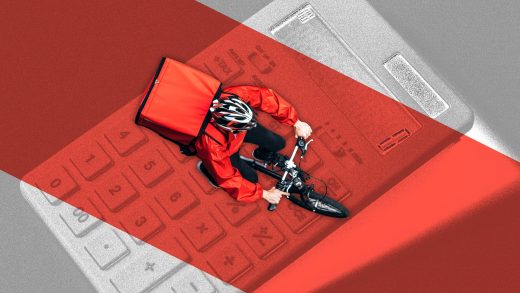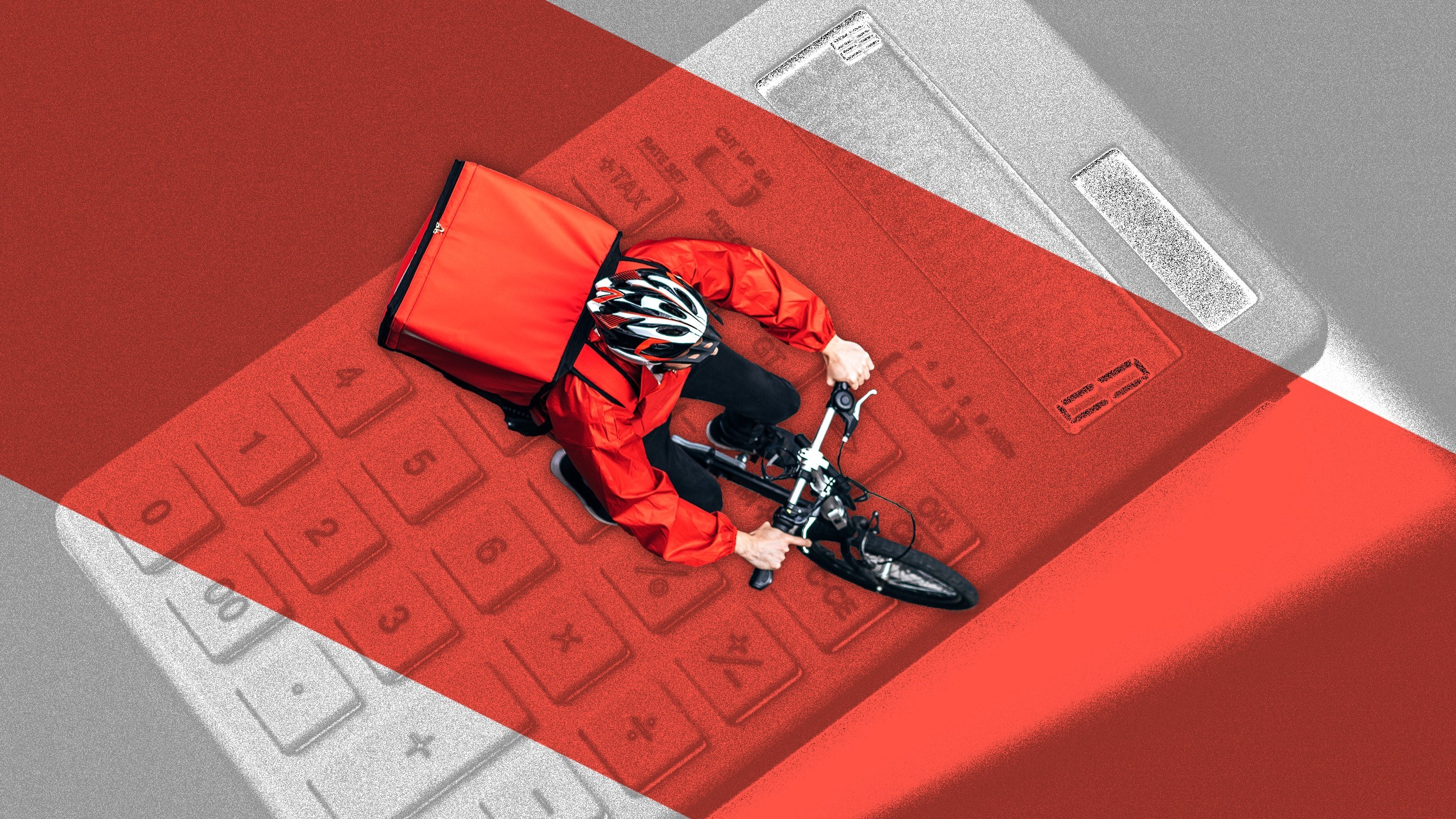Delivery workers won a mandated raise from NYC. Now they say the apps figured out a way to undermine it
After a protracted fight in the courts, a historic law took effect in December aimed at securing fair compensation for the 65,000 gig workers in New York City that enable food delivery services to stay in business. The law forces DoorDash, Grubhub, and Uber Eats to pay their workers a minimum of $17.96 an hour, or the equivalent if they opt to pay per delivery trip. By April 2025, another pay increase will bring their hourly wages up to nearly $20 an hour.
The minimum pay law is the first of its kind in the country and could be a major coup for delivery workers who previously earned only about $7.09 an hour excluding tips, according to a report by the NYC Department of Consumer and Worker Protection (DCWP). As individual contractors, delivery workers lack even basic labor protections and must shoulder the additional costs of gear and repairs. “I’m making about the same [amount] or more working just a few hours, [compared to] what I used to make working a whole day,” says William Medina, one of the lead organizers for Los Deliveristas Unidos, a coalition of delivery workers that was a driving force behind the law.
Another delivery worker, Alejandro Grajales, says he can now earn $100 in about four hours, when it used to require 10 hours of work. Across social media, delivery workers are sharing screenshots of their weekly earnings and urging their peers to drive safely rather than scrambling to complete orders. (A lesser-known service called Relay Delivery is currently exempt from the law, per an appeals court ruling, because it uses a different model that solely focuses on getting food from restaurants to customers.)
Just weeks after minimum pay was introduced, however, delivery workers are fighting to hold onto their gains. The law was designed in part to account for the rules imposed by delivery apps, which can penalize workers for long delivery times or limit when they can log on. But delivery workers claim these issues have been exacerbated, a move that many of them see as a direct response to the minimum pay requirements. The three apps that dominate the New York City market—DoorDash, Uber Eats, and Grubhub—all use some kind of verification process, which requires delivery workers to add information like a government-issued form of identification. But Medina alleges the companies have been cracking down on this process of late, leading some workers to get locked out of their accounts or fail to get approved in the first place.
Many delivery workers have also found that companies are restricting when they can log onto the app, which they claim effectively curbs the number of hours they are able to work. “For example, in Grubhub, [delivery workers are] working 10 or 15 hours a week,” Medina says. “And obviously this is not enough.” In a statement, Patrick Burke, a spokesperson from Grubhub, said, “When the Department of Consumer [and] Worker Protection first proposed the new minimum pay rate for delivery partners, we were clear that it would have unintended consequences that would limit work opportunities for couriers and reduce the number of orders restaurants receive. Grubhub has taken steps to comply with the new minimum pay rate for delivery partners in New York City while still operating a sustainable business given the added costs to now operate in the market.”
Uber recently rolled out a new scheduling system called Planner, which explicitly limits how many delivery workers can be online at any given point, citing new regulations that have “changed how delivery apps like Uber Eats work in New York City.” (The minimum pay law does not require that companies limit access to their apps.) Delivery workers in Manhattan have been especially impacted by these maneuvers, Medina says, due to the sheer density of workers. “Most of the cases that we’ve been seeing or observing [are] from Manhattan because the market is much bigger,” he says. “There’s more workers and more companies competing to beat each other, so they’re being more aggressive to the workers.”
The experiences reported by workers seem to vary by app: On Grubhub, for example, workers can receive violations if an order takes too long to be delivered; if they rack up three violations, their account is deactivated. Lately, Medina and others allege workers have been getting violations for taking too long to complete deliveries, even if they had no control over the delivery time because, say, a restaurant delayed the order. “It’s not our fault if we have to wait 20 to 30 minutes in one restaurant,” Grajales says. Medina adds that when workers try to report these issues to the company, “they don’t care about it.” The result, according to workers, is that they have to rush to meet the delivery timelines set by Grubhub, even if it means compromising their own safety.
The nature of their work—which often involves weaving through traffic to complete orders on time—leaves delivery workers vulnerable to all kinds of safety issues, from bike thefts to injuries sustained on the job. In 2021, a study conducted by the Worker Institute at Cornell University and the Worker’s Justice Project, the group that helped organize Los Deliveristas Unidos, found that of the 500 workers surveyed, 54% had their bike stolen at some point. Across Facebook pages like El Diario de los Deliveryboys en la Gran Manzana, delivery workers frequently document and alert each other to these thefts, which can leave them unable to work. These spaces also serve as a record of the incredible risks that delivery workers bear on the job: Sergio Solano, one of the delivery workers behind El Diario de los Deliveryboys en la Gran Manzana, recently told the New York Times that more than 40 workers have died since the page was created in late 2020. (The DCWP report also found that between January 2021 and June 2022, the fatality rate for delivery workers who don’t use a car was 36 deaths per 100,000 workers, making it one of the most dangerous jobs in the U.S.)
Since the pay increase, Grajales says his experience with DoorDash has improved where safety is concerned; he doesn’t feel as rushed while using the app and can “respect the traffic lights.” But the app has made other subtle changes to its interface—most notably, moving the tipping prompt so customers are not asked to tip while placing an order. The new design requires that customers remember to tip after a delivery is completed, the effects of which are already being felt by delivery workers who say this change strongly discourages tipping. Medina says they aren’t sure if customers are forgetting to tip or opting out altogether, but the impact is clear. “We don’t know what is happening,” he says, “but right now, for the majority of orders, [the tip] is zero.” Prior to the wage increase, delivery workers were making about half of their hourly wages through tips, per the DCWP report. Uber has similarly tweaked its tipping structure. In a statement, an Uber spokesperson said, “We are starting to see the impact of the rule—fewer couriers working less hours, competing against each other to do more deliveries faster. Pretty much what the City predicted would happen in its study.”
“Policies have consequences, and these changes come as a direct result of the extreme earnings standard imposed in New York City,” a DoorDash spokesperson said in a statement. “The City itself acknowledged that platforms could make changes to our tipping structure to help meet the significantly increased costs, which is exactly what we’ve done and therefore should come as no surprise.” (DoorDash has also previously made the argument that the minimum pay rate “does not reflect the way the industry operates” because DCWP excluded grocery delivery apps—such as Instacart—from the scope of the law.)
The apps have tried to frame these changes as an inevitability, noting in public statements that modifying the tipping and scheduling functionality is a byproduct of the city’s new pay standards for delivery workers. But delivery workers and their advocates point out that many of these moves aren’t exactly without precedent. Grubhub and DoorDash already limited access to their apps at certain times, to keep supply in line with demand. The advocacy group Justice for App Workers—which also includes drivers for Uber and Lyft—had warned that this would only escalate after the minimum pay law went into effect. “Our coalition has also been sounding the alarm about lockouts for months, and unfortunately, they have already started,” the group said in a statement. And just a few months ago, delivery workers recovered $22,000 in lost wages after lodging complaints with the DCWP against DoorDash, alleging the company had withheld payments by locking them out of their accounts over issues with verifying their identification and bank information.
“Has it gotten worse? Yes,” says Ligia Guallpa, the co-executive director of the Worker’s Justice Project. “But they’re using the exact same retaliatory actions they’ve taken before. They want to send a clear message to workers that minimum pay has consequences.” Guallpa argues companies are merely using the new law as an excuse to make changes that seem designed to negatively impact their workers and limit their earnings potential. “Companies have said that they had to change tipping because of minimum pay,” she says. “That’s false. That’s a business decision.” This messaging has been so effective that the minimum pay proposal reportedly sowed discord even among members of Los Deliveristas Unidos, who worried that delivery companies would respond in kind. “It’s a difficult situation because we need to explain the minimum pay,” Medina says, “but also we have to explain [how] they use this kind of retaliation against delivery workers to divide the workforce.”
With the introduction of laws that regulate the use of e-bikes in NYC, delivery workers are also facing new challenges on the job—expenses that they are expected to foot as individual contractors. (Last week, the Department of Labor enacted a new rule intended to address the widespread misclassification of gig workers, though food delivery companies have been quick to note that the rule likely would not impact their business models.) “What the companies don’t value is that our operating costs have significantly increased,” says Antonio Martinez Solis, another delivery worker and leader with Los Deliveristas Unidos who spoke through a translator and cited recent legislation regulating the use of e-bikes. “Now, many landlords are not allowing us to park our e-bikes in the building, so we have to rent a parking lot. And we have to buy new equipment. All these costs are not covered by the company.”
Even as these companies continue to push back against the new law, delivery workers reiterate that they can already see how minimum pay is reshaping their working conditions. “Of course the pay increase is significant,” Solis says. “Now that the companies are seeing that we’re making more money, they’re making our lives much harder. For them, it’s not about us or paying us more; it’s about protecting their own pockets. But us as workers, we have tested the apps—and we’re seeing that we’re making much more money and working less.”
(6)



